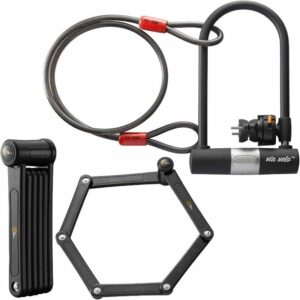Can An Electric Bike Be Used As a Regular Bike?
Key Takeaways
-
An electric bike can indeed be used as a regular bike, offering riders the flexibility to use it with or without the motor’s assistance.
-
The weight of an e-bike can make it more challenging to ride without motor assistance compared to a regular bike. However, understanding and effectively using the gear mechanism can make this more manageable.
-
Using an e-bike as a regular bike has several benefits, including promoting physical fitness, increasing versatility, and extending battery life.
-
Potential drawbacks include the extra weight and possible maintenance needs. Balancing between electric and manual use can help mitigate these issues.
-
The ability to use an e-bike as a regular bike enhances its functionality and adaptability, making it an appealing choice for a wide range of cyclists.
-
Remember: whether you’re going for a challenging ride or a leisurely cycle, your e-bike can adapt to your needs. Enjoy the ride
Flexing Versatility: Navigating the Dual Use of Electric Bikes
-
Cycling is a joyous and healthful activity appreciated by many. In recent years, electric bikes, also known as e-bikes, have seen a surge in popularity. They’ve been embraced by a wide demographic due to the ease of use, enhanced speed, and the physical boost they provide. But what if you fancy a traditional cycling experience? Can an e-bike be used just like its conventional counterpart? The short answer is, yes!
In essence, an electric bike is simply a traditional bike equipped with an added electric motor, offering the option to assist your ride. This essentially means that you can either pedal it manually like a regular bike or use the motor for a more relaxed journey. But, the switch isn’t always as simple as turning off the motor. The nuances of weight, gear mechanisms, and riding experience come into play. In this article, we’ll delve into these aspects in more detail, helping you understand how to maximize the dual capabilities of your e-bike.
So, strap your helmet on and join us as we pedal through the ins and outs of using an electric bike as a regular one!
The Dual Nature of Electric Bikes
Understanding the Mechanism of E-Bikes
Electric bikes blend the world of traditional biking with modern technology, offering a dual nature that can adapt to your changing needs. At the heart of an e-bike is its electric motor and battery. The motor, which is typically integrated into the front or rear hub, or sometimes the mid-frame, provides an assistive force when you pedal. This assistance can be adjusted according to your needs, and in many cases, can also be completely switched off.
In addition, e-bikes come with a control unit, often mounted on the handlebar, which allows you to control the level of assistance and monitor battery status. When you turn the pedal assistance off, your e-bike essentially behaves like a regular bike, albeit a slightly heavier one due to the motor and battery.

E-Bikes Functioning as Regular Bikes
When used without motor assistance, an electric bike works through the same mechanical principles as a traditional bicycle. You pedal, which turns the chain, which in turn rotates the wheels. The gears on an e-bike function just like those on a traditional bike, allowing you to adjust your pedaling effort according to the terrain or your exercise goals.
Using an Electric Bike Without Power
Riding an electric bike without the power engaged might seem counterintuitive, but it can be an excellent way to maximize your e-bike’s versatility and adjust your riding style according to your needs.
The Process and Experience of Riding an E-Bike With the Motor Turned Off
To ride an e-bike without power, all you need to do is switch off the pedal-assist feature through the control unit. Once the motor assistance is disengaged, your e-bike essentially becomes a regular bike.
Riding an e-bike without power might feel slightly different from riding a traditional bike, mainly due to the extra weight of the motor and battery. However, with a little practice, many riders find that they can adapt to this difference with relative ease.

Pedaling Effort Required
The pedaling effort required to ride an e-bike with the motor turned off is generally higher than when the motor is engaged, and also slightly higher than on a regular bike of a similar size and style. This is due to the additional weight that you’ll be propelling.
However, it’s important to note that many e-bikes come with multiple gears just like traditional bikes, which can help ease your pedaling effort, especially on inclines or difficult terrains. This allows you to adjust the difficulty of your ride, providing a flexible biking experience that can be tailored to your fitness level and riding preferences.
Factors to Consider When Using an E-Bike as a Regular Bike
When it comes to using an e-bike as a regular bike, there are a few key factors to consider that can influence your riding experience.
Weight
Electric bikes are typically heavier than their traditional counterparts. This is due to the added components such as the battery and motor. A typical e-bike can weigh between 20 to 30 kilograms, while a regular bike often weighs less than 15 kilograms.
The additional weight can make an e-bike harder to pedal without motor assistance, especially uphill. However, many riders find that they can adjust to the increased weight over time, especially with the help of the bike’s gear system.
Gear Mechanism
Just like regular bikes, most electric bikes come equipped with a gear mechanism. This mechanism can significantly ease your pedaling effort when the e-bike is used without power.
When the motor is turned off, you can shift to lower gears during steep climbs or high-resistance situations, just as you would on a traditional bike. On the other hand, for flat terrains or downhill slopes, higher gears can provide a smoother and more efficient ride.
 Battery Drain
Battery Drain
Even when the motor is turned off, the battery in an e-bike may continue to drain slowly. This is because the battery often powers other features of the e-bike, like the display, lights, or any electronic gear-shifting system.
If you’re planning to use your e-bike without power for an extended period, it may be beneficial to fully charge the battery beforehand. Regularly charging your battery can also help prolong its overall lifespan and ensure that motor assistance is available when you need it.
Benefits of Using an E-Bike as a Regular Bike
Using an e-bike as a regular bike comes with several unique benefits that can enhance your cycling experience.
Physical Fitness
One significant benefit of using an e-bike as a regular bike is the potential for physical fitness improvement. Riding an e-bike without power essentially mirrors the experience of riding a regular bike. Therefore, you can enjoy a similar level of cardiovascular exercise, promoting heart health, muscle strength, and calorie burn.
Additionally, the extra weight of an e-bike compared to a regular bike can provide an intensified workout, especially on uphill climbs.
Increased Versatility
E-bikes offer a fantastic blend of versatility. With the ability to turn the motor on or off, you can customize your riding experience based on your energy level, the terrain, or your workout goals. This adaptability allows you to use your e-bike for leisurely rides, intense workouts, or efficient commutes.
Adaptability to Different Terrains
Even without power, the structure and design of many e-bikes allow them to tackle a wide range of terrains. Mountain e-bikes, for example, are built to manage off-road paths effectively, even when ridden like a regular bike. Similarly, city e-bikes can comfortably navigate urban landscapes without the need for motor assistance.
Potential Drawbacks of Using an E-Bike as a Regular Bike
While using an e-bike as a regular bike has numerous benefits, there are potential drawbacks worth considering to ensure it suits your specific cycling needs and lifestyle.
Weight
As mentioned earlier, the weight of an e-bike, due to the motor and battery, is significantly more than a regular bike. Riding an e-bike without power on flat terrains or uphill can be more challenging and require more effort due to this additional weight. It can also make it more difficult to transport or store the bike.
Maintenance and Cost

E-bikes can require more maintenance than regular bikes. In addition to normal bike maintenance, you’ll have the added components of a motor and a battery. While these don’t typically require frequent care when used as a regular bike, they still add to the overall maintenance scope and cost.
The initial purchase price of an e-bike is also higher than a regular bike. If you primarily intend to use the bike without motor assistance, a regular bike could be a more cost-effective choice.
How to Make the Most of Your E-Bike
Knowing when and how to switch between electric and manual modes can significantly enhance your e-bike experience, giving you the best of both worlds.
When to Use Your E-Bike as a Regular Bike
If you’re using your e-bike for shorter, flat terrains, consider turning off the motor and using it as a regular bike. This not only extends the battery life but also gives you a chance for a more intense workout. Riding your e-bike manually in low-traffic areas can also be a fun way to enjoy a leisurely ride.
Balancing Electric and Manual Use
Understanding when to engage the electric motor is key. Use the electric assistance for long rides, steep inclines, or when you’re carrying heavy loads. Save the manual mode for shorter, flatter rides. This approach allows you to maximize the benefits of your e-bike while also getting a good workout.
Maintenance Practices
Regular maintenance checks will keep your e-bike in top shape, whether you use it in electric mode or as a regular bike. Pay attention to your bike’s battery life and ensure it’s adequately charged for your rides. Regularly service the mechanical parts, like the chain, gears, and brakes, just as you would with a conventional bike.
Embracing the Journey: The Final Word on E-Bikes' Dual Nature
In the evolving landscape of cycling, electric bikes are a transformative addition, bringing a unique blend of convenience and versatility. As we’ve discussed, an e-bike can indeed double as a regular bike, offering riders the flexibility to switch between electric and manual modes as needed.
The weight of an e-bike, compared to a regular bike, could be a challenge when riding without motor assistance. However, by understanding the gear mechanism and using it effectively, you can comfortably ride your e-bike even with the motor off.
There are several benefits to using an e-bike as a regular bike, such as promoting physical fitness and extending battery life. But remember to consider potential maintenance needs and to balance between electric and manual use, depending on your ride’s length, terrain, and load.
Ultimately, the ability to use an e-bike as a regular bike adds another layer of functionality to these versatile machines, making them an even more appealing choice for many riders. So whether you’re tackling a challenging trail or heading out for a leisurely ride, your e-bike is ready to adapt to your needs. Enjoy the ride!







